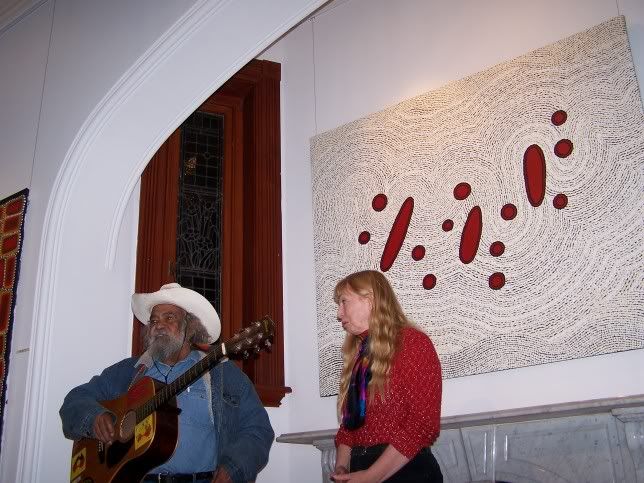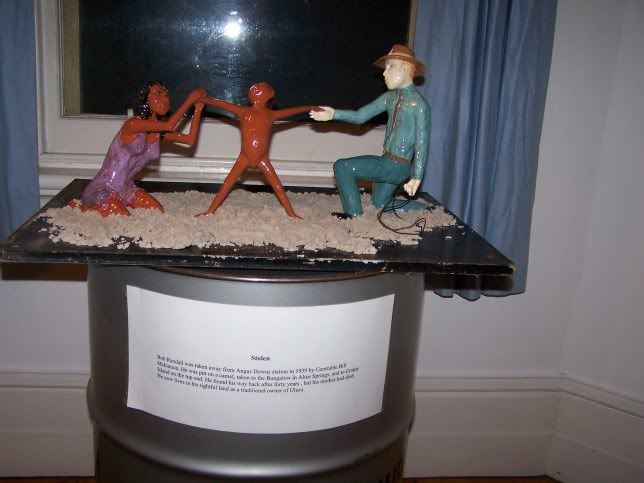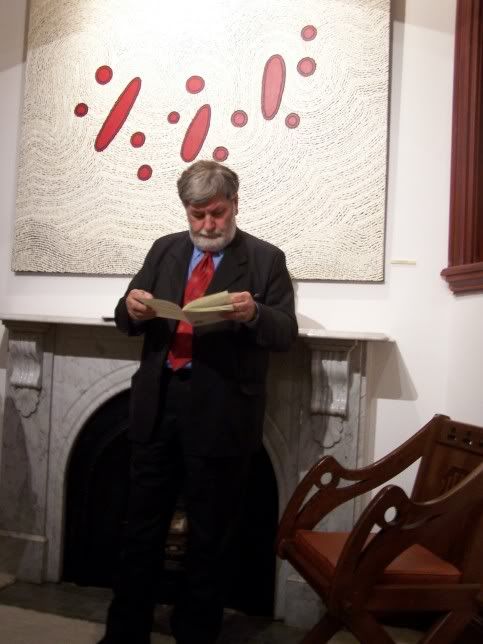
Tuesday, August 14, 2007
Banduk Marika: a prophetic voice

Thursday, July 19, 2007
Brenda Niall: Witness and Advocacy
 This week on Radio National's First Person, biographer Brenda Niall, is reading from her autobiography, Life Class. This morning she discussed the biography she did of one of Australia's great artists, Judy Cassab. Miss Eagle feels a sort of affinity with Cassab - on two occasions in her daily life she has gone to work each day to come face to face with a Judy Cassab. When Miss Eagle managed the Mount Isa Public Library, it was a very large portrait of Sir James Foots, a former Chairman of Mount Isa Mines Limited. Many years later, Miss Eagle worked in the Darlinghurst offices of Leon Fink, the well known Sydney art patron.
This week on Radio National's First Person, biographer Brenda Niall, is reading from her autobiography, Life Class. This morning she discussed the biography she did of one of Australia's great artists, Judy Cassab. Miss Eagle feels a sort of affinity with Cassab - on two occasions in her daily life she has gone to work each day to come face to face with a Judy Cassab. When Miss Eagle managed the Mount Isa Public Library, it was a very large portrait of Sir James Foots, a former Chairman of Mount Isa Mines Limited. Many years later, Miss Eagle worked in the Darlinghurst offices of Leon Fink, the well known Sydney art patron. Her desk was directly below a Cassab nude.
Her desk was directly below a Cassab nude.Monday, June 25, 2007
Aboriginal insecurity: thinking on vines and fig trees. Part 2. Mutitjulu and the invasion of 2007.
 Bob Randall and his daughter, Dorothea, are bearing witness to the insecurity felt by Aboriginal people in one community, Mutitjulu. Bob is a well-known singer and, just twelve months ago, was touring major cities promoting his movie, Kanyini, as well as the art of his wife Hazel Mackinnon. Miss Eagle posted on their Melbourne visit here. This year, Kanyini was voted the best documentary at the Australian Film Festival in London. Bob outlines, as so many communities do, the requests for assistance which have been made to the Federal Government and how those requests have been met with silence and neglect.
Bob Randall and his daughter, Dorothea, are bearing witness to the insecurity felt by Aboriginal people in one community, Mutitjulu. Bob is a well-known singer and, just twelve months ago, was touring major cities promoting his movie, Kanyini, as well as the art of his wife Hazel Mackinnon. Miss Eagle posted on their Melbourne visit here. This year, Kanyini was voted the best documentary at the Australian Film Festival in London. Bob outlines, as so many communities do, the requests for assistance which have been made to the Federal Government and how those requests have been met with silence and neglect.Saturday, May 19, 2007
Whither the spirit of '67
In this work Edna expresses the various groups who have come to Australia with the original Aboriginal people in the centre of the circle of reconciliation.
Earth colours dominate with the central circle showing a broken earth, symbolic of the current drought and the unfinished process of reconciliation.
Miss Eagle commends this article to you, dear Reader. This is the best article that Miss Eagle has read on the current status of Aboriginal people and the issues affecting them. It outlines the progress, the success stories, the failures and the neglect. It attaches blame. It shows the complexity of the topic and the ignorance of governments.
Miss Eagle was interested in the information that Fred Chaney, a former Liberal Aboriginal affairs minister ... has known every minister to have held the post going back to Billy Hughes.
Miss Eagle frequently uses Fred Chaney and Billy Wentworth as examples of the sort of Liberal governance that once prevailed in Australia. These men understood Aboriginal issues, they communicated with Aboriginal people, forged personal friendships in Aboriginal Australia and acquitted themselves well in Aboriginal matters.
There is no one - as far as Miss Eagle can see - in the Australian Government under John Howard who compares with these men. As far as Miss Eagle can see, there is no one in the Howard Government who has the ability to communicate with our First Nations. The great swing to the far right by the Liberal Party in the late 80s and early 90s saw to this. Such people had no value.
For this, Aboriginal people and the people of Australia in general have paid a great price.
Tuesday, June 13, 2006
Sense of Story
Hazel Mackinnon, Bob Randall's wife, is an artist and a listener. She says
Listening to people's stories, people who are relatives of Bob Randall and live in the desert region, I created the exhibition of Sculptures and Silk, The Stories of the Stolen Generation. There are a few people who can talk but most are deeply traumatised and affected by their treatment now and in the past. Our aim is to give these people a voice, for when they are heard, the healing can begin.
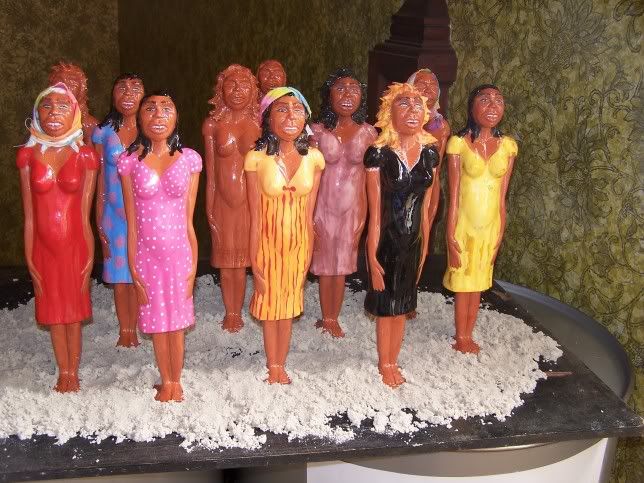
WAITING MOTHERS.
We cannot imagine the living hell that mothers go through waiting for their children to come back. Some mothers in their grief stricken minds visualise their child coming back as they were taken as a baby. Many, many mothers are still waiting for their stolen children.
Records of institutions are sometimes destroyed so names and histories are lost making it impossible for people to find their way home.
This is Miss Eagle's favourite piece. So poignant!
STOLEN
Bob Randall was taken away from Angus Downs station in 1939 by Constable Bill Mckinnon. He was put on a camel, taken to the Bungalow in Alice Springs and to Croker Islander on the Top End. He found his way back after forty years, but his mother had died. He now lives in his rightful land as a traditional owner of Uluru.
Miss Eagle commends Spiritual Songlines.
If you do nothing else towards Reconciliation between Settlers and the First Nations, visit this exhibition. Talk with Bob and Hazel. Glimpse the heartfelt feelings for the land and the wounds of its people. Learn how this country can transform and heal all of us if we just slow down, stop, and allow ourselves to listen and experience what has been provided for us.
Sunday, June 11, 2006
Sense of Place
Barry Jones AO standing in front of Malcolm Jagamarra's Inapaku 2004 prior to opening the exhibition.
Friday night saw Miss Eagle at Kinross House for the Uniting Arts Toorak launch of Spiritual Songlines. Spiritual Songlines is a magnificent exhibition of Aboriginal art which runs until Sunday 18 June. The exhibition has been auspiced by the collector David Carazza who collects works from the Central and Western Deserts.
This year, Kinross House - a magnificent Victorian mansion - has focussed on the theme "a sense of place" based on Sally Morgan's book My Place. Spiritual Songlines extends the theme into a national context with a sense of place, land and identity.
The goal, as outlined in the catalogue of the exhibition, is to:
- promote indigenous art in all its depth and colour through the paintings David Corazza has so generously made available;
- provide an opportunity for learning about aboriginal culture and spirituality through workshops, art and the movie Bob Randall brings from Central Australia;
- support Bob's efforts to support his community with actual, practical help;
- deepen our understanding of the issues that need to be addressed if first and new Australian cultures are to be reconciled and made whole. According to Bob such reconciliation can only come about through the love and understanding that grows when stories are told and the experiences are shared.
Miss Eagle must advise, dear Reader, that the exhibition is rather stunning - and Miss Eagle has seen quite a diversity of Aboriginal art. Artists whose work is represented at the exhibition are Josie Petrick Kemmarre and Minnie Pwerle from Utopia; Shirley Purdie and Madigan Thomas of Warmun (Turkey Creek); Jack Britten of Worranginy; Malcolm Jagamarra of Alice Springs; and Makinti Napanangka of Papunya. (Footnote: Miss Eagle carries the Warlpiri skin name, Napanangka)
The exhibition was officially opened by Hon Dr. Barry Jones, AO.
Monday, April 03, 2006
Sunday, April 02, 2006
Tuesday, March 28, 2006
Vale, Pro Hart
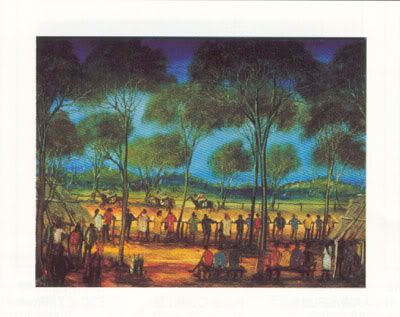
The Three Horse Race by Pro Hart
One of Australia's greatest brushmen of the bush is dead. Pro Hart, a commited Christian, has gone to another place.
Pro Hart was born in Broken Hill, NSW, Australia in 1928. He grew up on the family sheep station "Larloona" situated near Broken Hill, and he was educated by correspondence with this brother Bob, and their mother as tutor. In his early twenties, Pro moved to Broken Hill and worked underground as a miner. In 1960 he married Raylee June Tonkin and they had five children, three boys and two girls. To develop his gift, Pro attended a few local art classes but he was mainly self-taught. He was discovered in 1962 by a gallery director in Adelaide. From there his success as an artist began to flourish. Pro was nothing if not prolific. This together with his longevity has meant that the prices of his paintings were not governed by exclusivity. Even working class Australians could stretch things a bit to own a Pro Hart, even if it was only a small one.
People who loved the Australian bush and the lifestyle and the mystique of The Outback loved Pro Hart's work. He brought life and love to the depiction of our country. In fact, like his Maker with whom he now rests, he is truly a creative spirit.

.jpg)
